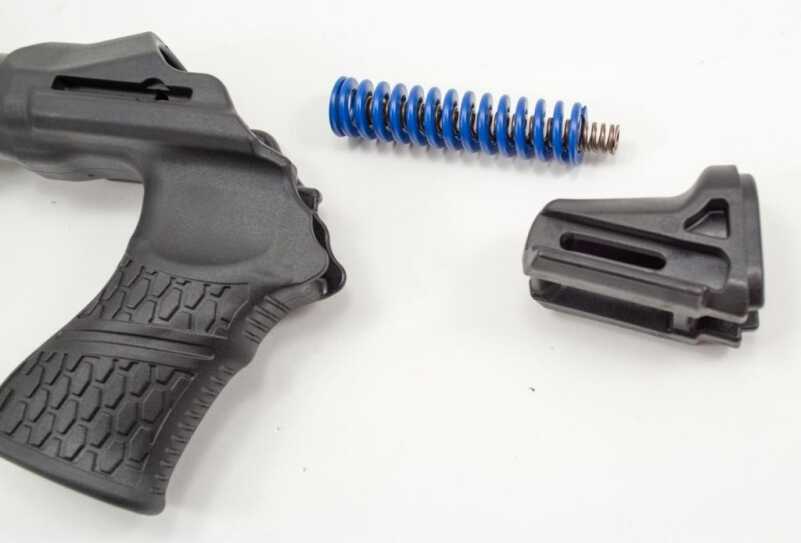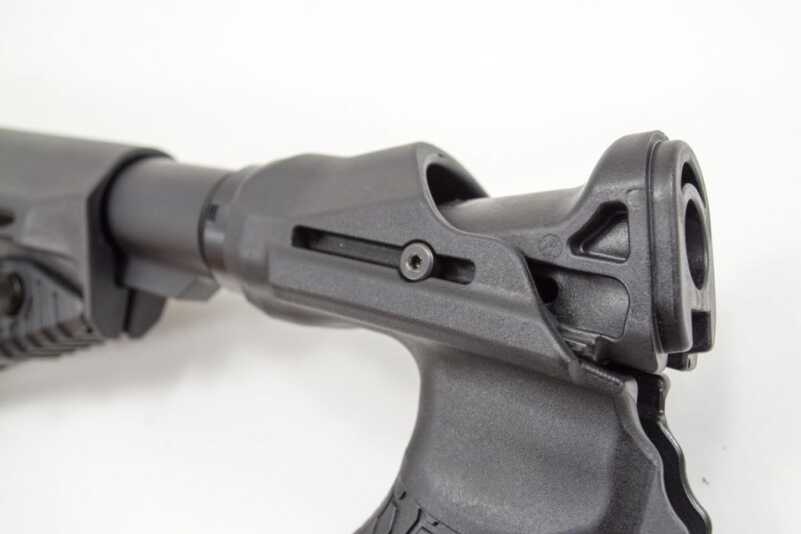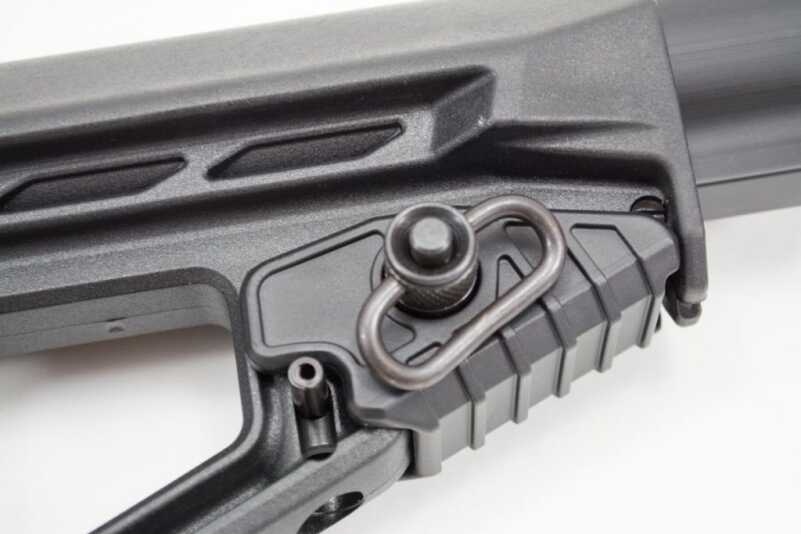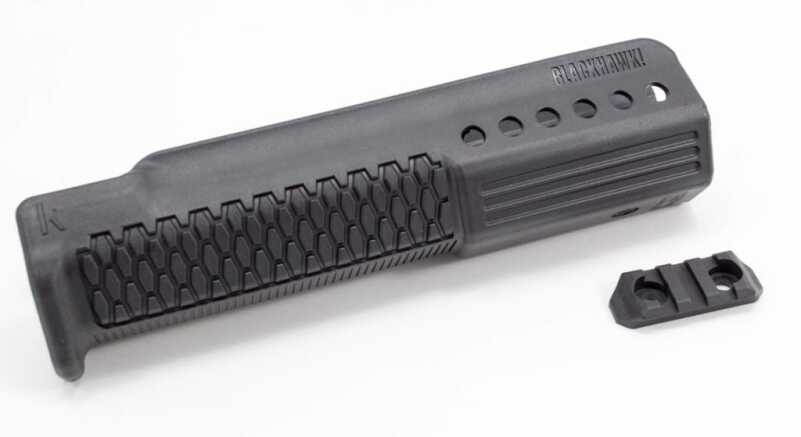
The Blackhawk Specops Gen III Shotgun stock is an advanced recoil-reducing accessory for your tactical shotgun. It comes with a replacement forend.
It’s hard to beat a Remington 870 for reliability in almost any conditions. A Remington 870 also likes to beat the taste right out of your mouth when it comes to recoil, especially when you’re shooting full-power slug and buckshot loads.
It all comes down to physics. The thump you feel when you pull the trigger is a direct result of the mass of stuff coming out the front end (projectiles and powder charge) and the velocity with which all that junk exits the fiery end. If you’re going to launch something like a one-ounce shotgun slug at 1,600 feet per second, you’re going to feel it on your shoulder and face. To put that in common handgun and rifle load perspective, a one-ounce slug is equivalent to a 437.5-grain bullet. So, using round numbers, a .45 ACP uses a bullet about half that weight and fires it at about half that velocity. And that doesn’t even count the much heavier powder charge in the 12-gauge shell which contributes to recoil too.
Let’s take it one level deeper. That “standard” .45 ACP load generates about 5.34 foot-pounds of recoil energy when fired from a Smith & Wesson SW1911 TA. As recoil energy also depends on the weight of the gun, I’ll note that this particular model weighs 41.7 ounces empty.
If we consider a Remington 870, say the Express Synthetic Stock Tactical Model, which weighs 7.5 pounds, it generates 23.66 foot-pounds of recoil energy when firing that one-ounce slug at 1,600 feet per second. A 1-1/8 ounce 00 buckshot load moving at 1,450 feet per second generates about the same. That’s almost five times as much recoil energy as the 1911 load.
But recoil energy is only part of what you feel. Another important factor is the time duration of the recoil impulse. Think of it this way. If Zombie Bruce Lee throat kicks you at full speed, your barbershop quartet days are over. If he does the same move, but 100 times slower, it won’t be any big deal. Even though the “force” is the same, it’s happening so slowly that you won’t feel much of anything.
This is exactly one of the big driving principles behind the Blackhawk Specops Gen III Shotgun Stock, priced at $159.95. There are two engineering features that both reduce the force you feel during recoil and spread that reduced force out over a longer period of time. The net result is massively reduced “felt” recoil. Energy doesn’t disappear, so it’s still there. It just gets redirected in lots of fancy ways.
Here’s how it works.
After removing the stock from your standard 870, you attach a small component called the “top slide” directly to the 870’s receiver. This top slide mounts into the actual buttstock on slide rails. Between the top slide and the stock itself, you’ll find a dual spring system. This is the first of those engineering features I mentioned. It’s somewhat like dual recoil springs on compact pistols. The large outer and smaller inner spring allow you to calibrate the recoil dampening effect as the top slide moves into the stock against spring pressure during recoil. If you shoot lighter loads, just remove the inner spring.

Most of the recoil reduction magic happens here. The top slide (right) and stock (left) are separated by dual recoil springs (center) that slow down the recoil impulse.
You get some extras with the recoil reducing stock upgrade, too. First and most obvious is a pistol grip. It’s made out of polymer and sports a nifty texture to help you hold onto the gun in wet and nasty conditions. Moving back, you’ll see what looks like a standard AR-type receiver extension tube. That’s because it is. It measures 1.17” in diameter, so it compares to a commercial buffer tube. That means that if you don’t like the included buttstock, you can pop one of your choice on there. But don’t rush out to do that because the standard one is nice. Like one on an M4 Carbine-pattern AR, it’s a six-position adjustable stock, so you can adjust the length of pull for preference or to fit your wardrobe whether it be winter clothing or body armor. While we’re on that topic, the length of pull varies from 12.5 to 15.2 inches. One more thing about the adjustable stock: There’s a tensioning screw just in front of the adjustment latch. This tightens the stock around the receiver extension tube so you can take out the wobble. That also serves to make stock adjustment require a little more deliberate force if you like.
The cheek rest section of the standard stock is wide and smooth so you can get a firm and comfortable weld. On either side of the stock adjustment latch, you’ll find quick detach sling swivel holes. Oh, and a quick detach sling swivel with a one-inch loop is included. There’s also a vertical slot for sling attachment if you prefer that method. At the very back you’ll notice a very thick recoil pad made with a sporty honeycomb pattern. Yes, it looks cool, but this part makes up the second recoil-reducing component. Press hard into that with your thumb and you’ll see how it flexes under recoil.
The kit also includes a replacement forend, because, why not? If you’re going to upgrade the butt stock, you might as well put on a spiffy matching forend too. It’s not just decorative, it adds some functional capabilities too. In the package, you’ll find a 1.5-inch Picatinny rail segment. You can mount this to either side of the forend at different positions using a series of six mounting holes on either side. The two mounting areas are not vertical but angled slightly in towards the barrel. They’re placed in front of the area intended for your support hand, so lights, lasers or whatever else you might want to stick on there will be out of the way and nothing will be obstructed by your hand. The hand grip area is also hard polymer and has a similar texture to the pistol grip. The hand stops are molded in to help prevent your hand from slipping out of position when working the action.
So how does it shoot?
I had the opportunity to try these at a factory event where I could test four different guns side by side using the exact same ammunition. All 870s, one had the new Gen III stock, one had a Gen II stock, one had the standard 870 fixed stock, and the last was a pistol grip only configuration for breaching.
I guess this is a good time to mention that you can get a pistol grip only system too if you’re into blowing up locks and charging into suspected meth labs. The product manager launched a few rounds downrange from this gun shooting one-handed. Obviously, this is not a recommended practice and was only done here under controlled conditions to show the impact of even the pistol-grip-only recoil reduction system. That was kind of neat.
Back to the tests. We shot Federal 12-gauge 2¾-inch Magnum 4 buck pellet loads. These leave the muzzle at 1,250 feet per second and will wake you up in the morning when fired from a pump gun like the 870. Remember our earlier example that showed 23.66 foot-pounds of recoil energy? This load has 34 pellets weighing 1-5/8 ounces and generates a whopping 39.25 foot-pounds of recoil energy according to my ballistic engineer friend Andrew Chamberlain, who authored the “Cartridge Comparison Guide.”
Shooting this load from the standard 870 was not at all fun. Sure, you can pop off a few rounds here and there with no ill effect, but it’s not something you would want to shoot in volume. However, when fired from the 870 outfitted with the Blackhawk Specops Stock, it felt far more like a birdshot load than the Magnum whopper it is. While hard to quantify in words, the birdshot load comparison is probably pretty accurate. You still know you’re shooting a 12 gauge, but it’s much, much more manageable. With more standard slug or 00 buckshot loads, one would have no problem completing extended practice or training sessions.
The bottom line here is that science can work. Given that this setup goes on a pump gun, there’s no reliability impact. If you pump the action, the gun will fire, so you don’t have to worry about upsetting any delicate inertia or semi-automatic gas systems.
Hey, one more quick self-preservation tip. If your shotgun has a scope or optic, make sure you set things up so there are at least three inches of eye relief clearance. The receiver will move back towards you as part of the recoil reduction process, so you want to make sure there’s enough clearance to avoid a black eye.




Have a Judge,3 1/2 in. SS. Bought +/- 6-8 yrs. ago. Mine is very accurate,both 45.lc.and 410. slugs.I use it mostly in a snake inhabited vacant orange grove behind my property. Over the yrs. I have nailed + 10 bad snakes (rattlesnakes and real coral snakes. I always go “locked and loaded” with an Alaskan chest rig, witch carries the revolver,extra ammo,phone and small med-kit. You do have yo get used to the Judge,with plenty of practice but still a very reliable neat gun.I should note that I am 100% disabled USN veteran using a power wheelchair. I do transfer to an old(96′) Polaris ATV when going on that acreage and around my own property.
Will this stock fit any 870 model? I have a 870 express super mag with the 3 1/2 inch chamber and want to make sure this stock will fit it?
Does the honeycomb tend to get dirty/hard to clean? Looking at a couple buttstock upgrades and this is one of my concerns for this one.
I have to over and understand with the Mercury anti recoil tubes one a very expensive gun with a grade 5 stock on it and neither seem to do all that much recoil adjustment. I bought them that way so it’s my fault but I am totally sold on the uselessness of the system. All they seem to do is make the gun heavier. In spite of this I do use them frequently.
Is there anything like this available for a Benelli Super Nova? Thanks
The only shotgun you mentioned was the Remington 870. Will be his system work on other brands of shotguns like the Mosberg 500 series?
No official word on that yet. There are more Remington 870s than anything on the market, so I get starting with a model for that shotgun. As Blackhawk! is now part of a publicly traded company (Vista Outdoor) they have to be tight-lipped about future product plans, so I couldn’t say for sure.
In th article you stated they had both the last gen and this gen stocks. Did you compare the two? I have an 870 with the last gen, and would like to know if it’s worth the upgrade. Thanks
I did try the Gen 2 and Gen 3 side by side. There was a noticeable difference, but it would be hard to tell you whether the difference is worth upgrading or not. They’ve definitely improved the effectiveness and ergonomics though.
I have a question that I am sure someone on this site can answer, maybe the author. I have a semi auto shotgun and have been curious if one is able to put a recoil reduction stock on a semi auto shotgun? does it hamper the semi autos gas operated ability to work as a semi auto shotgun? or does it compromise it’s ability in one way or another? any constructive feedback on this question would be appreciated.
This type of system won’t work as it will interfere with the action and you won’t be able to mount it. However, there are other approaches. Buttpads are one. Another option is mercury recoil reducing tubes. These mount in the stock (you might have to drill a hole if you have a wood stock) and dampen the recoil effect.